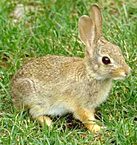Wildlife Rescue Information
• My Dog Found Baby Bunnies (PDF file)
• I Found a Bunny Nest (PDF file)
• I Found a Baby Squirrel (PDF file)
Chicago may be one of the largest metropolitan areas in the country, but a surprising number of wildlife populates both the city and the suburbs. In general, the best rule of thumb for dealing with wildlife is to leave them alone. Do not try to "rescue" them unless it is clear that the animals need help. Your definition of "help" may not be the same as the animal's.
Do not try to tame them or make them into pets. Wild animals cannot be domesticated, nor do they want to be.
Here is a brief guide to the best ways of dealing with wildlife you might encounter:
Rabbits
Don't Rush to "Rescue"
Many people discover a nest of wild baby rabbits and want to "rescue" them. The truth is that most of those baby rabbits are not orphans and do not need help. In fact, interfering with nature and trying to rescue them can cause more harm than good.
Mother rabbits only feed babies once a day, and then for only five minutes. They do not "sit" on the nest; in fact, they tend to stay away from the nest in order not to attract attention to it. Do not assume that the baby rabbits are orphaned just because you don't see a mother rabbit nearby. Usually the mother rabbit only comes at dawn.
If you accidentally disturb a rabbit nest, try to reconstruct it as best you can. Usually the nests are hidden under leaves, twigs and debris, or located under shrubs. But sometimes you will find a rabbit nest right in the open. You can move a nest up to 10 feet from its original spot if that will provide more cover for the nest. Cover it over with leaves, twigs and grass clippings. The mother rabbit will find it. It is a myth that rabbits will abandon their babies once human beings have touched them.
If your dog disturbs a rabbit nest, put the baby rabbits back in the nest and try to reconstruct it as best you can. Try to keep your pet animals and any children away from the nest for several weeks. After a few weeks, baby rabbits are mature enough to go out on their own.
Do not try to raise wild baby rabbits by yourself. Less than 10-percent of wild baby rabbits can survive with human "nursing." And only a licensed wildlife rehabilitator can legally try to rescue wild baby rabbits.
Wild or Pet Rabbit?
Wild rabbits are called cottontails; their tails look like balls of cotton. They might have a white mark on their foreheads or under their chins, but over all they are a brown tweedy color known as agouti coloring.

Wild rabbit
They cannot be domesticated. It is against the law to try to make a pet out of any kind of wildlife.
All too often these days, pet rabbits are being abandoned outside. These rabbits can be all different kinds of colors: white; black-and-white; orange; brown-and-white; black. Even some pet rabbits have brown agouti coloring. Some pet rabbits have ears that go up; others are lops, with ears that hang down.
No pet or domestic rabbit can survive on his own outside. Just because wild rabbits live outside does not mean that a pet rabbit will be OK. Pet rabbits that are dumped outside become prey for all kinds of creatures--dogs, cats, owls, coyotes, foxes, abusive human beings—as well as hosts for any number of deadly parasites.
A pet rabbit abandoned outside will inevitably meet a painful death. Any pet rabbit found outside should be rescued immediately and brought into safety.
True Orphans
If you are absolutely sure that a nest of wild rabbits are true orphans (that is, that the mother rabbit has been killed), then those rabbits need to get to a wildlife rehabilitator. See the resources below to find a wildlife rehabilitator.
Injured Rabbits
If you find an injured wild rabbit and cannot get it to a wildlife rehabilitator, you need to get the rabbit to a rabbit veterinarian or a veterinary emergency clinic.
Raccoons, opossums, squirrels and birds
If you find an injured wild animal like a raccoon, opossum, squirrel, chipmunk, woodchuck or any kind of bird, see the resources below to find a wildlife rehabilitator.
If you see a naturally nocturnal animal like a raccoon during daylight hours, give it a wide berth. It is probably sick, possibly rabid.
Often in the spring, people will find young birds, called fledglings, on the ground. Usually they have fallen out of their nest. You can pick them up and return them to the nest. Birds will not abandon their babies because a human being has touched them. If you can't reach the nest, place the fledgling up high in a bush for protection.
Bats
If you find an injured or sick bat, you should leave it alone. It could be rabid. Call 911 (in Chicago, call 311) and ask for Animal Care and Control. Local Animal Care and Control will come out and remove the bat for testing.
Skunks
If you find abandoned baby skunks, you should phone a rehabilatator first. Often, the baby skunks are not truly abandoned by their mother. If you must move baby skunks, wear rubber gloves first. Skunks can carry rabies.
Any skunk large enough to require two hands to pick up is old enough to be on its own.
If you must move an injured adult skunk, wear rubber gloves. Skunks spray when they are frightened; their eyesight is poor. Speak to the skunk in a low voice so that it realizes you are approaching.
The Center for Disease Control recommends that people do not keep skunks as pets because of the likelihood of their passing on various diseases, including rabies.
Resources:
Flintcreek Wildlife: 847-842-8000
Willowcreek Wildlife Center: 630-942-6200